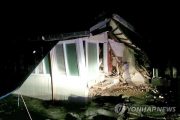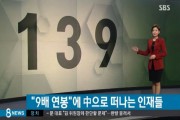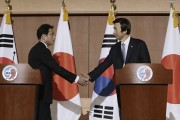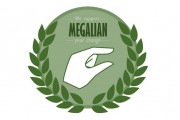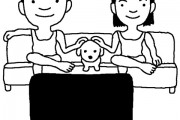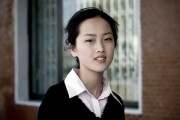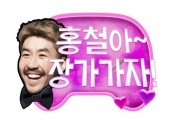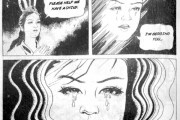North Korea is always making headlines for political reasons, but we still know very little about daily life in the nation, and very little about its domestic culture. A recent blog post on the website of the South Korean Ministry of Unification has provided netizens with a rare glimpse inside the North Korean beauty industry, by highlighting the hairstyles on offer for North Korean women.
Bringing together a series of photographs from various sources inside North Korea, the post reveals a previously unknown side to popular culture in the country, demonstrating that even in the difficult living conditions faced by many North Koreans, beauty and personal appearance plays a significant role in the lives of many women. While the South Korean concern for beauty is well-known, few have questioned how women in the North feel about their personal appearance. The post is translated in full below, along with all the original photographs that accompanied it.
From Ministry of Unification Blog:
What Are the ‘Hot’ Hairstyles for Women in North Korea?
Hello, I am Na Hana, a young freshman journalist for the Ministry of Unification’s co-existence journalism group.
Today, I’m going to introduce something about hairstyles for women in North Korea.

A while ago some photographs taken by a Chinese photographer of the Ch’anggwang-won beauty salon in P’yongyang, which has a rich history, were made public and have become talking point. Through these photographs, we can catch a glimpse of the various hairstyles that are offered to men and women in the beauty salons of P’yongyang, and they have garnered the interest of many netizens.



Below is a photograph taken in Pyongyang on a Sunday by a foreigner called Eric Lafforgue. It is a pictorial explanation of how women dress up elegantly in hanbok (or what is known in North Korea as ‘Choson dress’) on special occasions, perhaps they are going to lay flowers at the bronze statue of Kim Il-Sung or they might have been invited to some special place. And so, through the Chinese photographer’s photographs we can confirm that they separate the hairstyles worn when women wear hanbok (Choson dress) with those from when they wear Western-style clothes, and that there are many different styles displayed in beauty salons.
 © Eric Lafforgue
© Eric Lafforgue
With traditional Korean dress, they generally wear ilja meori [straight style] or jjok meori [an updo], and with western clothes there are many more styles, usually styles such as chobal meori [braided hair], sugukhwa meori [hydrangea style] (where the front and sides of the hair are set into strong waves) saeng meori [loose hair], holeum jobal meori [another type of braided style], and p’ado meori [waved hair] (where the mid-lengths of the hair are loosely permed and blow-dried).

Hairstyles Worn with Korean Dress

Hairstyles Worn with Western Dress
Apart from these, as the representative hairstyles for North Korean women there are styles such as hambak-kkot meori [peony style] (a style with a tight perm put into the mid-layers of the hair), okryu meori [okryu style] (perming and setting long hair, then dragging up the sides on top of the head and decorating with hairpins), yang t’eol meori [wool style] (a style where short hair is curled like wool), and daehaksaeng meori [university student style] (a short style with a falling fringe).

As ‘convenient services facilities’ North Korean beauty salons include things like beauty, hairdressing, bathing, and laundry, with one salon in each li and dong, with three or four staff working in each normal-sized salon and around ten hairdressers and beauticians working in larger salons. Depending on circumstances, such as difficulty in obtaining products and staff shortages, beauty salons operating properly in small towns are rare, but salons such as Pyongyang’s Ch’anggwangwon, Hashinmokyukt’ang beauty salon, Daedongkyo beauty parlour, Munsu parlour, Puksae parlour and so on, are known as famous places.

In order to obtain the qualifications to become a hairdresser, those who receive recommendations as middle school graduates or from other workplaces are trained through education at a hairdressing or beauty school in each town or district more than once per year, and in September of every year they even hold a competition for the north’s most skilled beauty salon, ‘Nationwide Hairdressers’ and Beauticians’ Competition’ in P’yongyang. The March 2003 edition of the magazine of the General Association of North Koreans Resident in Japan, ‘Homeland Monthly,’ which is published by the Choson News Company, introduced the victor of the event, the winning beautician Kong Hoon-mi. She was trained at the Institute of Complete Beauty Techniques in P’yongyang and Daedong-kang, and has published books such as ‘Beauticians and Hairdressing,’ and ‘Hairdressing for Housewives.” As far as beauticians are concerned, they have a favourable social position inside North Korea, and it is said that these beauticians are virtually all women.
Another special feature of North Korean women’s hairstyles is the differentiation in styles for unmarried women and married women; in particular for those women who are unmarried, wear uit’ae mori, a hairstyle with a ribbon which is braided into a single strand, and Ssangt’ae mori, where the hair is parted and braided into two plaits. Whereas they can wear styles for long hair, should a married women wear this style it seems they would be frowned upon. In fact, even in South Korea, if a middle-aged woman was to wear her hair long and loose, she might even be considered awkward. As the times change, it seems that the boundaries also break down. In South Korea, there is the tendency to think that hair braided into two plaits is thought to be something only for young children. On occasion, university students and celebrities will playfully do this, and sometimes when I put my hair in plaits for fun, I too get frowned at.

A Braided Hairstyle for Unmarried Women

A Short Style for Married Women
It was stated in a domestic press release that beauty education in North Korea is gradually being converted to an educational method that establishes a consistent system for training institutions by means of apprenticeship. Furthermore, the way that beauticians are given a wage is changing from a fixed monthly salary to a policy of extra pay based on talent. In addition to this, the development of a computer simulation program in which you can create various hairstyles on an avatar-like image is already under way, and it seems that several technical methods, such as the usual perming with rods, razor cuts, blow dries and roller-sets are being used. In particular regarding information like the way to use a steam perm machine and the creation of various make-up products that were included in a magazine published in North Korea, it seems that this reflects a concern with beauty in North Korea.
However, based on interviews with North Korean defectors, due to a lack of resources the use of electronic appliances such as dryers is not easy, and rather than using the convenient facilities of the beauty salon, they have the procedures in private homes with ‘beauty parlour’ signs hung [outside them]. While there are difficult circumstances, such as using a reduced amount of the chemicals used for perming, substituting scare plastic perming rods for wooden chopsticks and uding vinegar instead of neutralising agents, most women try to make themselves beautiful, imitating the fashion of well-dressed people at the market and TV announcers. Of course, the party, which attempts to regulate the people, publicly criticises men with excessively long hair and women with gaudy hairstyles.
In 2001 a famous South Korean hair designer visited P’yongyang, and held a national hair conference for professional beauticians. Should there be unification, the hairstyles that women can choose will become more diverse, and I think that we can look forward to the appearance of different hairstyles becoming popular in the Korean peninsula. My heart is filled with hope.
